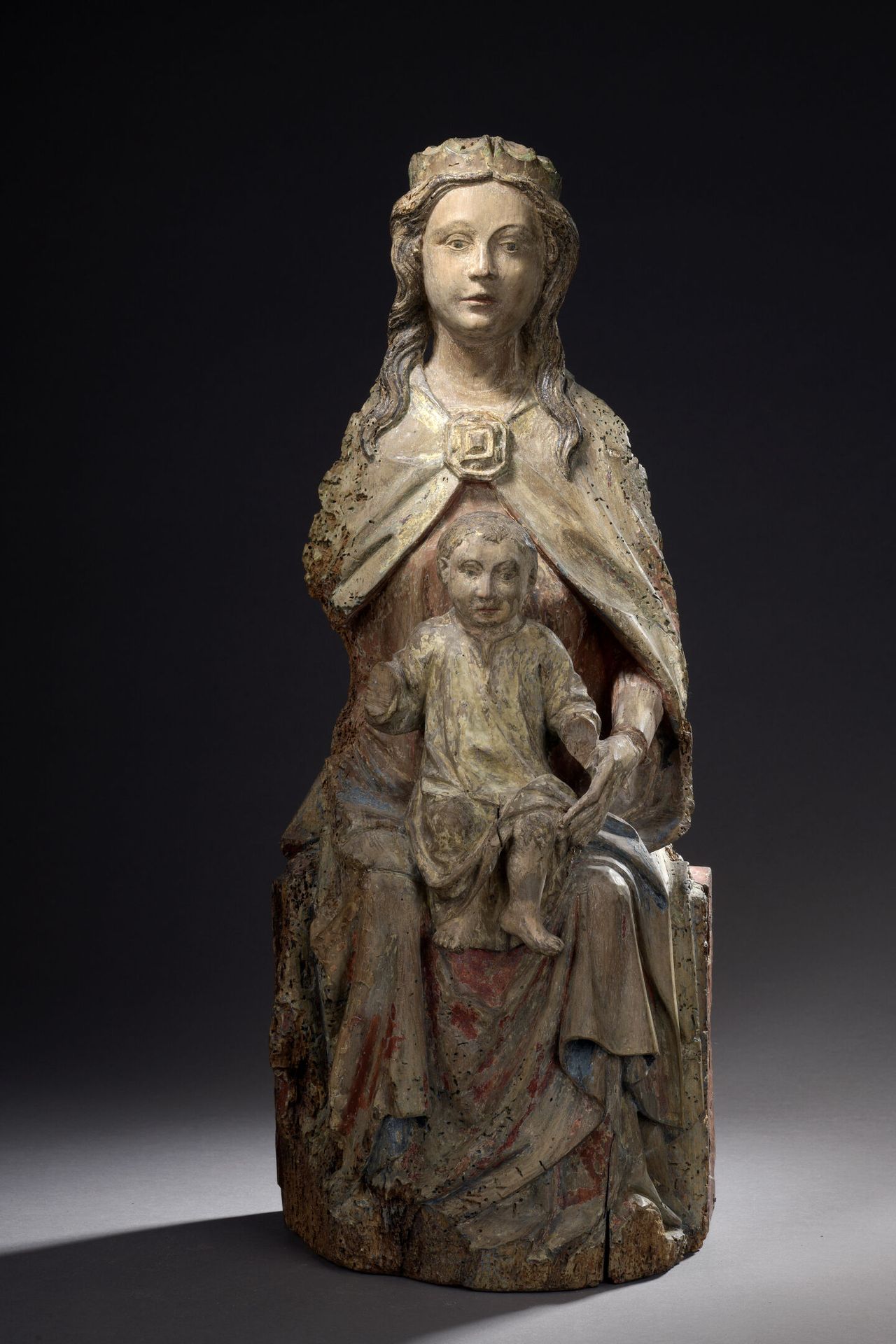Description
Central France, second half of the 15th century Seated Virgin and Child "Sedes Sapientiae Carved applique fort-relief in polychromed wood H. 61 cm AL-EJ Damage, worming and missing parts This seated Virgin and Child is a rare representation of the Sedes Sapientiae Virgin from the late medieval period. The frontal position of the Mother of God with the Child Jesus on her lap is the major element of this iconography, codified in the 12th century under the impetus of a theological model developed after the upheavals of Western Christianity in the previous century. These devotional figures of the Virgin in Majesty spread and flourished throughout the Middle Ages. At the beginning of the 14th century, the composition was challenged by the new Marian representation of the Virgin standing and holding her child on one arm. A need for humanization explains the gradual loss of the solemn characteristics of the enthroned Virgin for compositions in which the seated Virgin nurses the Child, holding him upright or seated, deported on one knee. The quest for naturalism, reflected in the soft, high-browed face of this Virgin with its bulging forehead and loose hair, is nevertheless indicative of a 15th-century work, as are the features of the Child's small feet, the movement of the drapery, well-defined to animate the lower part, and the presence of a rich clasp in keeping with the fashion of the time. The Child is no longer crowned and, like some of the Children of the Virgins of the Flemish Primitives (cf. Roger Van der Weyden, Durán Madonna, c. 1435-1438, oil on canvas, 100 x 52 cm, Madrid, Prado Museum, inv.P02722), he simply wears a tunic concealing his nudity. At a time when devotion was striving to make the divine figure more accessible, the humanization of the Infant Jesus was invested with a high symbolic value. This humanization is underlined by the tunic, the color of which premonitatively recalls his shroud. But this humanization is counterbalanced by the frontal attitude of Jesus, who was originally making a gesture of blessing with his right hand. The combination of the elegant, graceful style of this Virgin with her distant gaze, typical of production in the second half of the 15th century (particularly in the central regions of France) and this Romanesque hieraticism make this work a true rarity in late medieval statuary. It is highly probable that, like the only two other 15th-century Virgins of the same attitude (preserved at the Dijon Hospital), it was executed to replace an already honored but damaged Romanesque Sedes Sapientiae.
20
Central France, second half of the 15th century Seated Virgin and Child "Sedes Sapientiae Carved applique fort-relief in polychromed wood H. 61 cm AL-EJ Damage, worming and missing parts This seated Virgin and Child is a rare representation of the Sedes Sapientiae Virgin from the late medieval period. The frontal position of the Mother of God with the Child Jesus on her lap is the major element of this iconography, codified in the 12th century under the impetus of a theological model developed after the upheavals of Western Christianity in the previous century. These devotional figures of the Virgin in Majesty spread and flourished throughout the Middle Ages. At the beginning of the 14th century, the composition was challenged by the new Marian representation of the Virgin standing and holding her child on one arm. A need for humanization explains the gradual loss of the solemn characteristics of the enthroned Virgin for compositions in which the seated Virgin nurses the Child, holding him upright or seated, deported on one knee. The quest for naturalism, reflected in the soft, high-browed face of this Virgin with its bulging forehead and loose hair, is nevertheless indicative of a 15th-century work, as are the features of the Child's small feet, the movement of the drapery, well-defined to animate the lower part, and the presence of a rich clasp in keeping with the fashion of the time. The Child is no longer crowned and, like some of the Children of the Virgins of the Flemish Primitives (cf. Roger Van der Weyden, Durán Madonna, c. 1435-1438, oil on canvas, 100 x 52 cm, Madrid, Prado Museum, inv.P02722), he simply wears a tunic concealing his nudity. At a time when devotion was striving to make the divine figure more accessible, the humanization of the Infant Jesus was invested with a high symbolic value. This humanization is underlined by the tunic, the color of which premonitatively recalls his shroud. But this humanization is counterbalanced by the frontal attitude of Jesus, who was originally making a gesture of blessing with his right hand. The combination of the elegant, graceful style of this Virgin with her distant gaze, typical of production in the second half of the 15th century (particularly in the central regions of France) and this Romanesque hieraticism make this work a true rarity in late medieval statuary. It is highly probable that, like the only two other 15th-century Virgins of the same attitude (preserved at the Dijon Hospital), it was executed to replace an already honored but damaged Romanesque Sedes Sapientiae.
